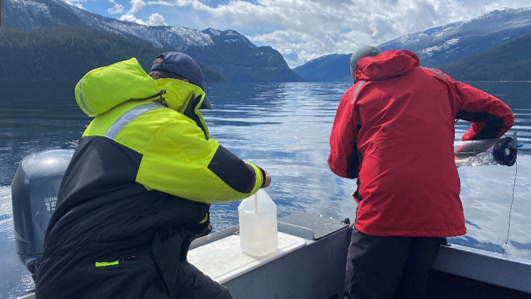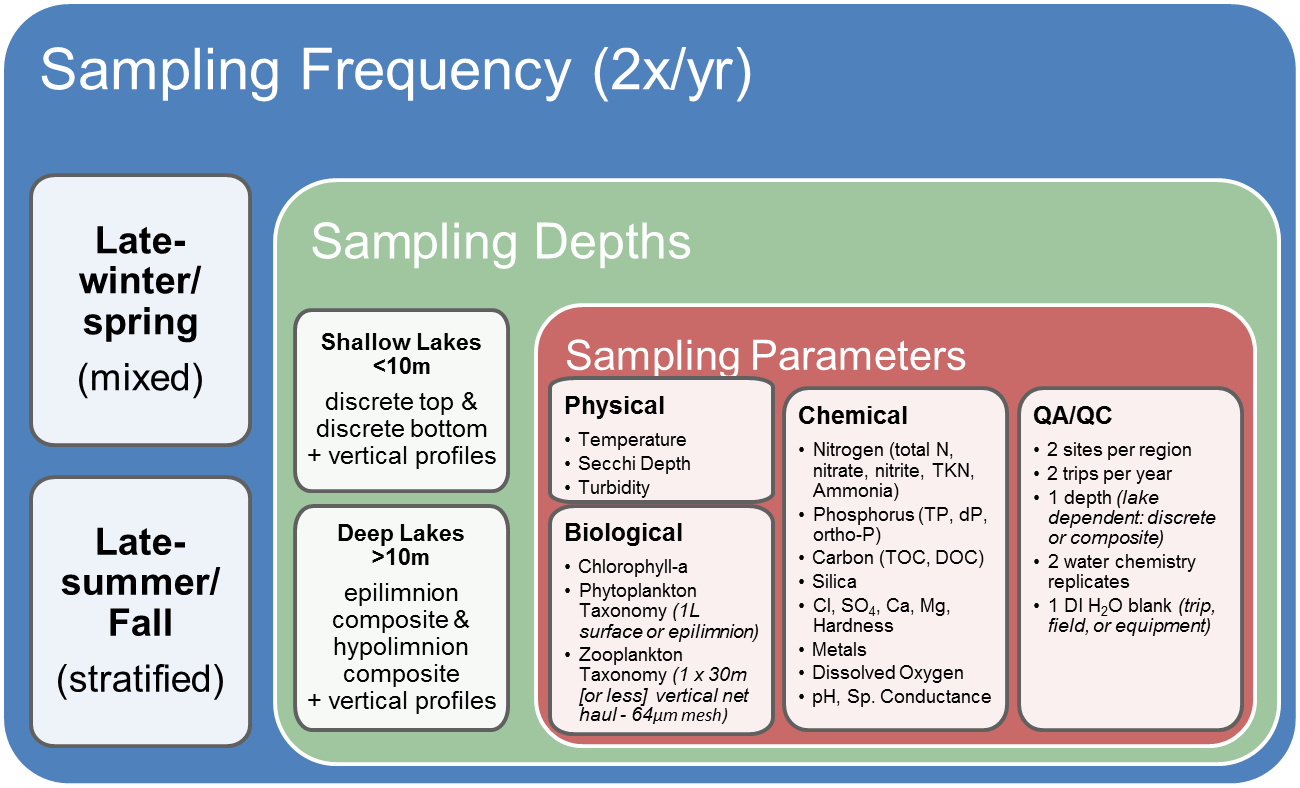Lake sampling strategy
Lake sampling technique and effort has been standardized to provide a consistent province-wide approach. Sampling occurs twice a year, once in late-winter / spring (February to May, depending on location and ice melt) when the water column is in mixed conditions and once in the late-summer / fall (August to September) when the water column is stratified.
Water samples
Water chemistry samples are collected from multiple depths. For shallow lakes (<10 m), this includes one (1) discrete surface grab sample (1 m below water surface), as well as one (1) discrete bottom grab sample (1 m above sediment surface). For deep lakes (≥10 m), this includes one (1) composite from the epilimnion and one (1) composite from the hypolimnion. Water clarity is also measured as Secchi depth at each site.
Vertical profiles
Vertical profiles for temperature, dissolved oxygen, specific conductance, and pH, are obtained using multi-parameter sondes. For shallower sites, measurements are taken every meter (1 m) until the bottom is reached. For deeper sites, measurements are taken every meter (1 m) up to 20 meters, and then every five meters (5 m) up to 45 meters.
Plankton
A one (1) liter phytoplankton sample is collected from either the discrete surface sample (shallow lakes) or from the epilimnetic composite (deeper lakes). Zooplankton samples are collected via vertical net hauls (lake surface to 30m for deeper lakes and lake surface to 1m off of bottom in shallower lakes). Depending on the site, invasive zebra / quagga mussel veliger (larval mussel) sampling may also be conducted in the late-summer / fall sampling.

Quality Assurance / Quality Control
- Two (2) sites per region
- Two (2) trips per year
- One (1) depth (lake dependent)
- Two (2) water chemistry replicates
- One (1) blank with deionized water
|
Field |
General |
Major Ions |
|---|---|---|
|
Temperature |
Chlorophyll-a |
Calcium Total |
|
Secchi Depth (Water Clarity) |
Hardness (Total) |
Chloride Dissolved |
|
Dissolved Oxygen |
Turbidity |
Magnesium Total |
|
Specific Conductance (field) |
Specific Conductance (lab) |
Potassium Total |
|
pH (field) |
pH (lab) |
Sulfate Total |
|
Carbon Dissolved Organic |
Nitrogen - Nitrite Dissolved (NO2) |
Phosphorus Ort. Dissolved- P |
|
Carbon Total Organic |
Nitrogen Ammonia Total |
Phosphorus Total |
|
Nitrate (NO3) Dissolved |
Nitrogen Kjeldahl Total (N) |
Phosphorus Total Dissolved |
|
Nitrate (NO3) + Nitrite (NO2) Dissolved |
Nitrogen NO2 Total |
Silica Reactive Dissolved |
|
Aluminum Total |
Iron Total |
Silicon Total |
|
Antimony Total |
Lead Total |
Silver Total |
|
Arsenic Total |
Lithium Total |
Sodium Total |
|
Barium Total |
Manganese Total |
Strontium Total |
|
Beryllium Total |
Molybdenum Total |
Sulfur Total |
|
Bismuth Total |
Lead Total |
Thallium Total |
|
Boron Total |
Lithium Total |
Tin Total |
|
Cadmium Total |
Manganese Total |
Uranium Total |
|
Chromium Total |
Molybdenum Total |
Vanadium Total |
|
Cobalt Total |
Nickel Total |
Zinc Total |
|
Copper Total |
Selenium Total |
|

